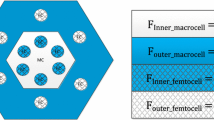Abstract
The scarcity of available spectrum in the 2–11 GHz frequency range and the continuously increasing number of users that require broadband communication services suggest that emerging fixed-broadband wireless access (F-BWA) networks will be deployed with aggressive frequency re-use to cope with capacity demands. In this context, co-channel interference may arise in high levels compromising the system's capacity and robust operation. Interference is further increased when limited directionality terminal antennas are employed to support non line-of-sight operation and in the case where an adaptive-time division duplex is selected for efficient radio resource management in asymmetric and time-varying traffic conditions. In this paper frequency channel assignment (CA) and antenna polarization assignment (PA) are considered as a means of mitigating interference. Two novel CA schemes that consider the distinct characteristics of F-BWA are proposed; the rotated-interleaved channel assignment and the non-uniform channel assignment. According to statistical interference simulation analysis the proposed schemes are more efficient in suppressing interference, achieving higher capacity compared to existing schemes while incurring no further complexity. In addition, instead of exploiting the performance of CA and PA schemes independently a framework for a joint CA-PA consideration is presented, where for a particular CA scheme an optimized PA pattern is developed. Results show that this approach improves the CA-PA interoperability increasing the overall performance. The efficiency of the proposed schemes is investigated for both FDD and adaptive-TDD schemes and is verified for various sectorization, frequency re-use and terminal antenna directivity configurations to ensure compatibility with different deployment scenarios.
Similar content being viewed by others
References
D. Gesbert, L. Haumonte, H. Bolcskei, R. Krishnamoorthy and A. Paulraj, “Technologies & Performance for Non-Line-of-Sight Broadband Wireless Access Networks”, IEEE Communications Magazine, Vol. 40, No. 4, pp. 86–95, Apr 2002.
C. Eklund, R. Marks, K. Stanwood and S. Wang, “IEEE Standard 802.16: A Technical Overview of the WirelessMAN Air Interface for Broadband Wireless Access”, IEEE Communications Magazine, Vol. 40, No. 6, pp. 98–107, Jun 2002.
J. Li, S. Farahvash, M. Kavehrad and R. Valenzuela, “Dynamic TDD and Fixed Cellular Networks”, IEEE Communication Letters, Vol. 4, No. 7, pp. 218–220.
O. Ata, H. Seki and A. Paulraj, “Capacity Enhancement in Quad-Sector Cell Architecture with Interleaved Channel and Polarization Assignments”, IEEE International Conference on Communications, No. 1, pp. 2317–2321, June 2001.
L. Wang and K. Leung, “Performance Enhancement by Narrow-Beam Quad-Sector Cell and Interleaved Channel Assignment in Wireless Networks”, IEEE Global Telecommunications Conference, No. 1, pp. 2719–2724, December 1999.
V.I. Roman, “Frequency Re-use and System Deployment in Local Multipoint Distribution Service”, IEEE Personal Communications, December 1999.
K. Ntagkounakis, P. Dallas and B. Sharif, “Joint Channel & Polarization Diversity Assignment for Capacity Enhancement in Non Line-of-Sight Fixed Wireless Networks”, 15 th IEEE International Symposium on Personal, Indoor and Mobile Radio Communications, Barcelona, Spain, 5–8 September, 2004.
K. Ntagkounakis, B. Sharif and P. Dallas, “A Non Uniform Channel Assignment Scheme for 2–11 GHz Fixed Broadband Wireless Access”, IASTED Conference on Communications Systems and Networks, Marbella, Spain, 1–3 September, 2004.
T. S. Rappaport, “Wireless Communications, Principles & Practice”, 2002, Prentice Hall.
Author information
Authors and Affiliations
Corresponding author
Additional information
Bayan Sharif received the bachelor and doctorate degrees from Queens University of Belfast and Ulster University, N. Ireland, in 1984 and 1988. In 1989 he held a research fellowship post at Queens University of Belfast, where he worked on parallel programming algorithms for two-dimensional signal-processing applications. He joined Newcastle University in 1990 as Lecturer, and was promoted to Senior Lecturer and Professor in Digital Communications in 1999 and 2000. During this period he held visiting academic positions with Colorado State University and the UAE Telecommunication Corporation (Etisalat). He is currently Head of the Communications and Signal Processing Research Group at the School of Electrical, Electronic and Computer Engineering and his research interests are in digital communications with a focus on the optimization of wireless networks and DSP algorithms for receiver structures. Prof. Sharif has published over 170 journal and conference papers, and held UK and EU research grants in digital communications and signal processing worth over 2M. He is a Chartered Engineer and Fellow of the IEE.
Panos I. Dallas (pdal@intracom.gr) was born 1967 in Thessaloniki, Greece. He obtained his diploma and Ph.D. degree from the Electrical and Computer Engineering Department of Aristotle University of Thessaloniki, Greece, in 1990 and 1997, respectively. Since 1998 he joined with INTRACOM where he currently is Section Manager of Advanced Communications Technologies branch of Emerging Technologies & Markets department, leading the next generation of broadband wireless access systems for internal and EU projects. He runs the relevant standardization activities (IEEE 802.16 and ETSI/BRAN HIPERMAN) in INTRACOM and he represents the company in WiMAX forum. Finally, he has over 30 publications in international journals and conferences.
Konstantinos E. Ntagkounak is received the B.Sc. in Electrical Engineering from Technology Institute of Chalkis, Greece, in 1998 and the M.Sc. in Communications & Signal Processing from University of Newcastle, UK, in 2001, where he is currently studying for a Ph.D. in Electrical Engineering. Since 2001, he is with INTRACOM S.A. as a research engineer involved with several European Union IST research projects in the area of Advanced Communication Technologies. His research interests include medium access protocols, radio resource management and network architectures for next generation broadband wireless access systems.
Rights and permissions
About this article
Cite this article
Ntagkounakis, K., Sharif, B. & Dallas, P. Novel Channel and Polarization Assignment Schemes for 2–11 GHz Fixed–Broadband Wireless Access Networks. Wireless Pers Commun 36, 425–443 (2006). https://doi.org/10.1007/s11277-005-9004-7
Published:
Issue Date:
DOI: https://doi.org/10.1007/s11277-005-9004-7




